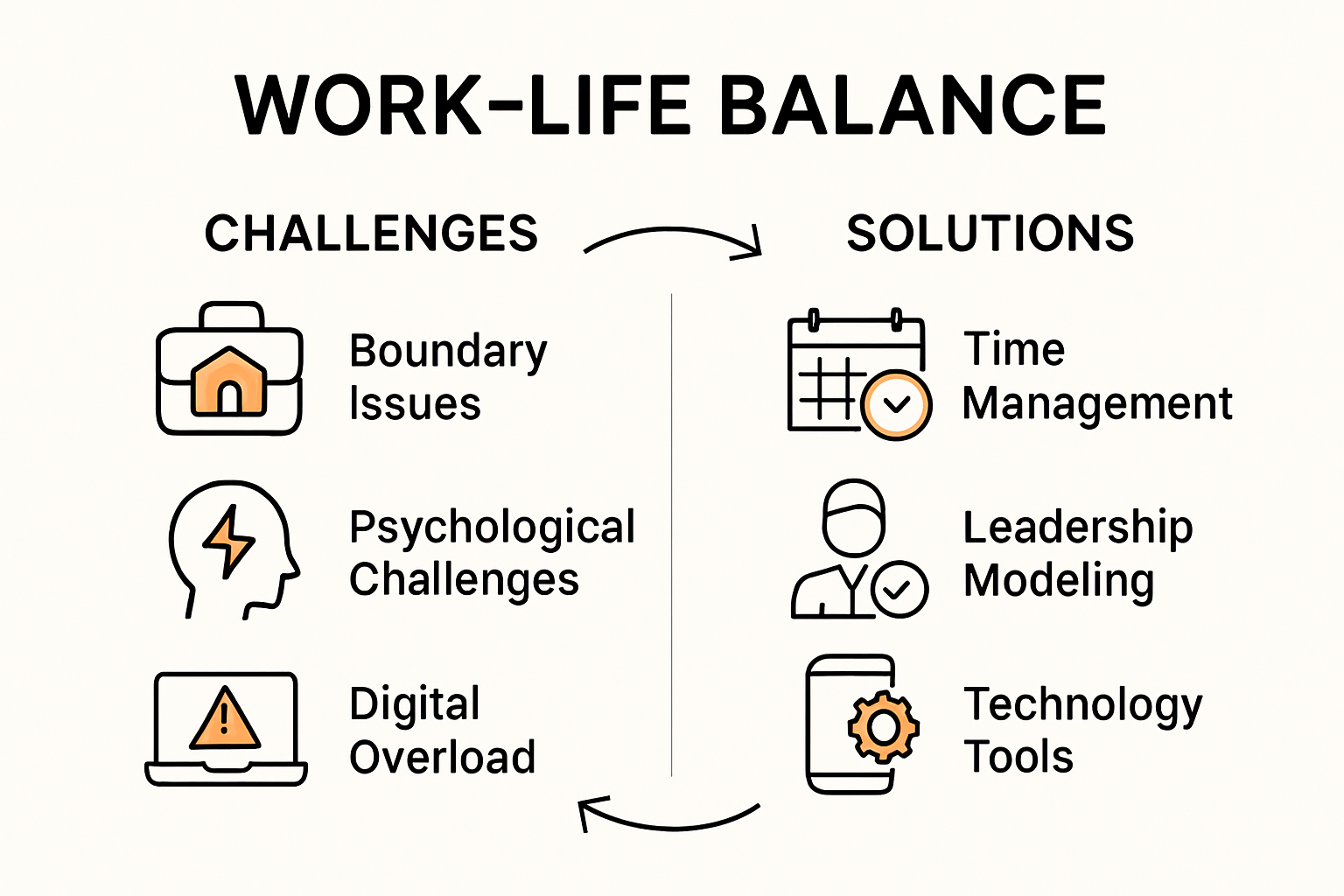Work-life balance is no longer just a corporate talking point and it’s now a make-or-break factor for team success and personal growth. Here’s something wild though. More than 75 percent of professionals say flexible schedules and well-being support are now their top job priorities—way ahead of pay. That flips the old philosophy on its head and in 2025 the smartest leaders are shifting away from rigid work patterns and are rethinking what it truly means to thrive at both work and home.
Table of Contents
- Defining What Is Work-Life Balance In 2025
- Why Work-Life Balance Matters For Teams And Leaders
- Common Challenges And How To Overcome Them
- Effective Strategies To Improve Work-Life Balance
Quick Summary
| Takeaway | Explanation |
|---|---|
| Work-life balance is personalized | Each individual’s definition of balance varies based on circumstances, making a one-size-fits-all approach ineffective. |
| Leaders must model work-life balance | By demonstrating healthy boundaries and self-care, leaders encourage their teams to prioritize personal well-being. |
| Strategic design of work environments | Creating flexible and structured workspaces helps employees achieve better work-life integration and reduces stress. |
| Technology enhances balance | Leveraging smart tools can help manage workloads effectively and create healthy separations between work and personal life. |
| Address boundary challenges proactively | Establishing clear professional and personal boundaries is essential to minimize stress and promote satisfaction in both areas. |
Defining What Is Work-Life Balance in 2025
Work-life balance has evolved dramatically in recent years, transforming from a trendy corporate buzzword into a critical strategic approach for modern organizational success. As we step into 2025, understanding what work-life balance truly means becomes paramount for leaders navigating increasingly complex professional environments.
The Modern Interpretation of Balance
Traditionally, work-life balance suggested a strict separation between professional and personal domains. However, contemporary research from Gartner defines it more holistically as an employee’s ability to manage both professional responsibilities and personal needs with adequate time for rest and personal fulfillment. This nuanced perspective recognizes that balance isn’t about equal time allocation, but about feeling empowered and in control across different life spheres.
Professional leaders now understand that work-life balance isn’t a one-size-fits-all concept. According to Professor Anna L. Cox, it’s fundamentally about “feeling in control of how you balance various demands to support and enable wellbeing.” This means individual definitions will vary based on personal circumstances, career stage, and individual preferences.
Technological and Cultural Shifts Redefining Balance
The emergence of remote work, artificial intelligence, and flexible scheduling has dramatically reshaped traditional work-life boundaries. Leaders in 2025 recognize that balance isn’t about physically separating work and personal life, but about creating integrated, fluid experiences that support overall human performance and satisfaction.
Key technological enablers like advanced task management platforms now provide intelligent tools that help professionals dynamically adjust workloads, set boundaries, and maintain personal wellness. These solutions go beyond simple scheduling, offering AI-driven insights that help individuals optimize their energy, focus, and personal time.
Moreover, EBSCO Research Starters emphasize that achieving work-life balance involves strategic priority setting. Modern leaders understand this means consciously designing work environments and personal routines that support holistic performance rather than pure time management.
In 2025, work-life balance represents a sophisticated, personalized approach to professional and personal integration. It’s about creating synergistic environments where individual potential can flourish, recognizing that peak performance emerges not from rigid separation, but from thoughtful, dynamic alignment between professional aspirations and personal well-being.
The most successful leaders will be those who view work-life balance not as a static concept, but as a continuously evolving strategy for human potential—one that respects individual differences while maintaining organizational effectiveness.
Why Work-Life Balance Matters for Teams and Leaders
Work-life balance has transcended being a mere employee benefit to become a critical strategic imperative for organizational success. In 2025, leaders recognize that prioritizing work-life balance is not just about employee satisfaction but about creating high-performance ecosystems that drive innovation, productivity, and sustainable growth.
The Performance and Retention Equation
Research published in the International Journal of Environmental Research and Public Health highlights a compelling connection between work-life balance initiatives and organizational success. Companies that invest in robust work-life balance strategies significantly improve their ability to attract and retain top talent. This isn’t just about offering flexible schedules but about creating an organizational culture that genuinely values employee well-being.
The economic implications are substantial. When employees feel supported in managing their professional and personal responsibilities, they demonstrate higher engagement, lower burnout rates, and increased loyalty. Contemporary research from the University of Florida reveals that managers who successfully disconnect during off-hours are perceived as more effective leaders and help their teams maintain better performance and focus.
Psychological and Organizational Benefits
Beyond tangible performance metrics, work-life balance profoundly impacts psychological health and organizational dynamics. A groundbreaking study published in late 2023 demonstrated that access to work-family policies like flexible working hours indirectly enhances job performance by improving overall employee well-being.
Leaders who champion work-life balance create environments where creativity flourishes. When employees are not constantly exhausted or stressed, they bring more innovative thinking, emotional intelligence, and collaborative energy to their roles. Advanced task management platforms now provide intelligent tools that help professionals dynamically balance workloads and personal time, further supporting this holistic approach.
Moreover, work-life balance is no longer a generational preference but a universal expectation. Modern professionals across age groups and career stages demand environments that respect their multifaceted lives. Organizations that fail to adapt risk losing their most talented individuals to more progressive competitors.
In essence, work-life balance matters because it represents a fundamental shift from viewing employees as resources to recognizing them as whole human beings. It’s about creating ecosystems where professional achievement and personal fulfillment are not competing priorities but complementary aspects of a meaningful life.
The most forward-thinking leaders understand that work-life balance is not a cost center but a strategic investment in human potential. By prioritizing this balance, organizations don’t just retain employees—they cultivate resilient, innovative, and deeply committed teams capable of navigating the complex challenges of the modern business landscape.
Common Challenges and How to Overcome Them
Work-life balance is a dynamic and complex endeavor fraught with numerous challenges that can derail even the most well-intentioned professionals. Understanding these obstacles and developing strategic approaches to address them is crucial for leaders and teams seeking sustainable performance and personal well-being.
Recognizing and Addressing Boundary Challenges
Research from the National Institutes of Health emphasizes the critical importance of establishing clear boundaries between professional and personal domains. Modern professionals often struggle with constant connectivity, where digital technologies blur the lines between work and personal time. This persistent digital intrusion can lead to chronic stress, reduced productivity, and diminished personal satisfaction.
Key boundary challenges include overworking, inability to disconnect, and constant availability expectations. Leaders must proactively create cultures that respect individual time and discourage after-hours communication. Advanced task management platforms now offer intelligent tools that help professionals set and maintain healthy work boundaries, automatically managing communication flows and protecting personal time.
Psychological and Systemic Barriers
Academic research published in comprehensive studies reveals that work-life balance challenges extend beyond individual capabilities, deeply rooted in organizational cultures and systemic expectations. Professionals often face psychological barriers such as guilt about disconnecting, fear of being perceived as less committed, and internalized productivity myths that equate constant work with success.
Overcoming these barriers requires a multi-dimensional approach. Organizations must actively challenge outdated performance narratives, recognizing that sustainable productivity emerges from well-rested, psychologically healthy professionals. This means redesigning performance metrics to value outcomes over hours worked, implementing flexible work arrangements, and creating supportive environments that prioritize employee well-being.
Strategic Intervention and Personal Empowerment
Effective work-life balance isn’t about perfect equilibrium but about developing adaptive strategies. EDUCAUSE publications suggest that successful professionals actively curate their work-life integration through deliberate interventions.
These interventions include:
- Intentional Time Management: Blocking personal time with the same rigor applied to professional commitments
- Skill Development: Learning to negotiate boundaries and communicate personal needs effectively
- Technology Utilization: Leveraging smart tools that automate task management and create natural work-life separation
Leaders play a pivotal role in modeling these behaviors. By demonstrating healthy work-life practices, they create cultural permission for their teams to prioritize personal well-being. This isn’t about working less but about working more intelligently and sustainably.
Ultimately, addressing work-life balance challenges requires a holistic, compassionate approach that recognizes individual differences, respects personal boundaries, and creates flexible, human-centered work environments. The most successful organizations will be those that view work-life balance not as a problem to solve, but as a continuous, dynamic process of human optimization.

To help clarify the most common obstacles teams and individuals face, the following table summarizes key work-life balance challenges and practical solutions highlighted in this section:
| Challenge | Description | Potential Solution(s) |
|---|---|---|
| Overworking | Excessive hours, difficulty shutting off from work | Encourage disconnecting, model healthy boundaries |
| Inability to Disconnect | Constant work notifications and digital intrusion after hours | Use task management tools, set communication policies |
| Availability Expectations | Pressure to always be reachable and responsive | Implement boundaries, respect personal schedules |
| Guilt or Fear about Disconnecting | Worry of being seen as uncommitted when setting boundaries | Challenge outdated narratives, leadership modeling |
| Outdated Performance Metrics | Focus on hours (not outcomes), encouraging presenteeism | Shift to outcomes-based evaluation |
| Lack of Skill in Boundary-Setting | Difficulty communicating and negotiating personal needs | Provide training, encourage assertive communication |
Effective Strategies to Improve Work-Life Balance
Improving work-life balance requires a strategic and multifaceted approach that goes beyond simple time management. In 2025, successful professionals and leaders recognize that effective balance is about creating intentional systems, leveraging technology, and developing personal resilience.
Designing Intentional Work Environments
Mental Health America emphasizes the importance of setting manageable daily goals and being efficient with time. Leaders can support this by creating structured yet flexible work environments that prioritize outcomes over hours worked. Advanced task management platforms now offer intelligent tools that help professionals break down complex projects into achievable daily objectives, making work more predictable and less overwhelming.
The CDC’s Healthy Work Design and Well-Being Program highlights the critical role of workplace design in employee well-being. This means reimagining workspaces and workflows to reduce stress and support natural productivity rhythms. Strategies include implementing flexible scheduling, creating quiet zones for focused work, and designing collaborative spaces that energize rather than drain employees.
Leadership and Cultural Transformation
Supported by CDC research on workplace wellness, effective work-life balance is fundamentally a leadership responsibility. Supportive leadership behaviors can dramatically reduce workplace stressors and create environments where employees feel valued beyond their professional output.
Key leadership strategies include:
- Transparent Communication: Openly discussing work-life balance expectations
- Boundary Respect: Implementing clear policies about after-hours communication
- Holistic Performance Metrics: Evaluating employees based on results and well-being, not just hours worked
Leaders must model these behaviors personally, demonstrating that professional success and personal well-being are not mutually exclusive. This means visibly taking breaks, using vacation time, and showing vulnerability about personal challenges.
Personal Empowerment and Skill Development
Ultimately, work-life balance is a personal skill that can be developed and refined. Professionals need to become proactive architects of their own experiences, learning to:
- Set clear personal and professional boundaries
- Practice effective time and energy management
- Develop resilience and stress management techniques
- Continuously reassess and adjust their approach
Technology plays a crucial role in this personal empowerment. Modern professionals can leverage AI-driven tools that provide insights into productivity patterns, suggest optimal work schedules, and help automate routine tasks. This allows more intentional allocation of mental and emotional energy.
The most successful approach to work-life balance in 2025 is dynamic and personalized. It requires ongoing dialogue between individuals, teams, and organizational leadership. By treating work-life balance as a collaborative, evolving process rather than a fixed destination, professionals can create more sustainable, fulfilling work experiences that adapt to changing personal and professional needs.

Frequently Asked Questions
What is work-life balance in 2025?
Work-life balance in 2025 refers to the ability of employees to manage their professional responsibilities and personal needs effectively, emphasizing a personalized, dynamic approach rather than a strict separation between work and home life.
Why is work-life balance important for teams and leaders?
Work-life balance is crucial as it enhances employee satisfaction, boosts performance, fosters innovation, and aids in talent retention, ultimately leading to a healthier and more productive organizational culture.
What common challenges do individuals face in achieving work-life balance?
Common challenges include overworking, the inability to disconnect from work, constant availability expectations, and psychological barriers like guilt about taking personal time. These challenges often stem from organizational culture and systemic expectations.
What strategies can leaders implement to improve work-life balance in their teams?
Leaders can create intentional work environments with structured flexibility, model healthy work-life practices, communicate openly about expectations, and implement policies that respect personal boundaries while focusing on holistic performance metrics.
Turn Work-Life Balance Insights Into Real Results for Your Team
Is your team struggling to set clear boundaries and cut back on administrative overload, as discussed in our guide on modern work-life balance? Too often, leaders want to empower their teams but run into barriers like endless task management, constant notifications, or the pressure to always be available. The right system can change everything by making it easier to manage workloads without burning out.

With Gammatica.com, you get more than a typical management tool. Our AI-driven platform helps you take control of time, automate repetitive tasks, and design workflows that enable true flexibility—key strategies recommended in the article. Create seamless boundaries with integrated calendars, smart automation, and team collaboration features that protect your most valuable resource: your team’s well-being. Ready to let technology remove the friction from your daily operations? Visit Gammatica.com now or check out how our task management tools can simplify your day. Take action now to empower your team and achieve the kind of balance that drives sustainable success.
Recommended
- How to Manage Tasks Effectively in 2025: Proven Strategies for Leaders | Gammatica
- Collaborative Decision Making for Leaders: Strategies for 2025 | Gammatica
- Project Progress Tracking: Strategies for Success in 2025 | Gammatica
- Lead Management for Beginners: 2025 Guide for Teams and Leaders | Gammatica



